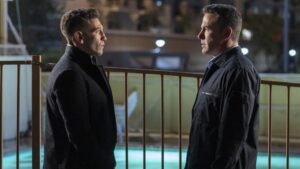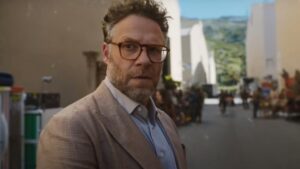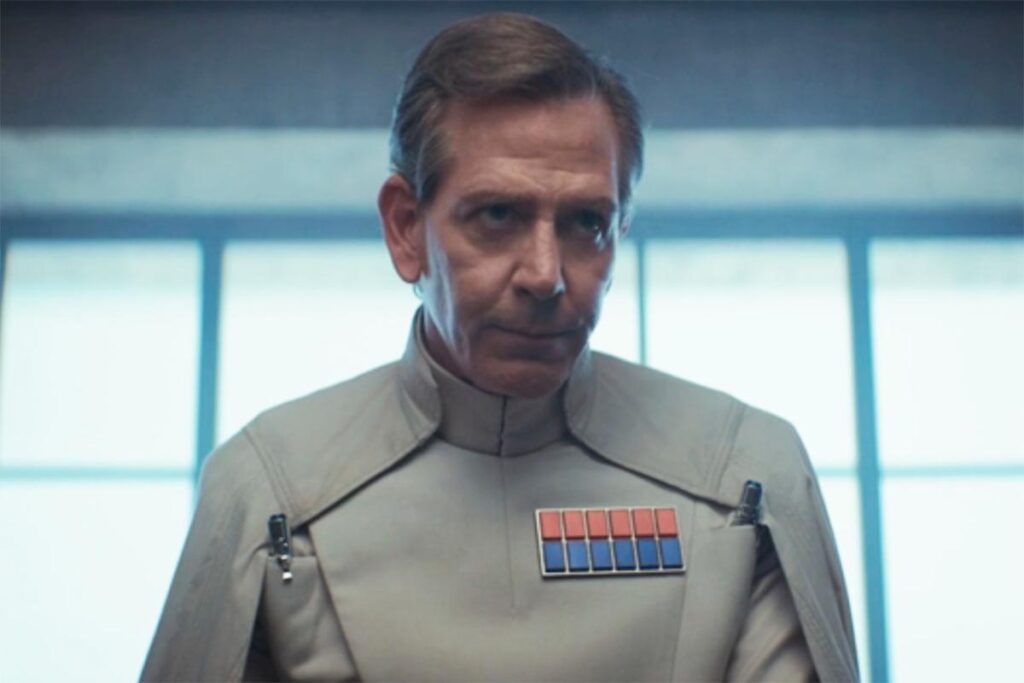It just hits different.
Sure, the intro montage is the same one you see before every other Disney Marvel TV show: blue and red lighting washing over a series of masks, helmets, and droid heads. The lack of a recognizable John Williams leitmotif highlights the ersatz nature of the imagery, and the shows it’s touting. It’s a curtain-raiser that tells you you’re about to see something mediocre.
Then a crescent of light appears in the void. A John Carpenter–influenced synth (Brandon Roberts is this season’s composer, working off themes by Season 1’s Nicholas Brittell) crescendos on the soundtrack. The word ANDOR slowly coalesces. And just like that, we’re back to the best thing the galaxy far, far away has seen since a long time ago.
Then a massive bell tolls, as text on the screen tells us it’s ONE YEAR LATER. We cut from this profound blackness, filled out by the sound of the tremendous GONNNGGGGG, to a dazzlingly white launch bay for fancy-looking TIE fighter. An Imperial technician (Rachelle Diedericks) strolls through as a sinister droid, its black carapace gleaming in the light, cruises along. The contrast is striking, enough to knock you back a bit. The design of the hangar is sterile and colossal. This looks like a scary place, a place we’re not meant to be.
In the capable hands of creator-showrunner-writer Tony Gilroy, that’s how the entire galaxy feels. On Andor, the fear, the danger, the stakes are all real in a way this franchise hasn’t seen in decades. This show is good in a way this franchise hasn’t been in decades. Like I said, it just hits different. Very, very different.
The plot for this opening salvo in the show’s second and final season is surprisingly simple. A year after the riot on his home planet that led to his joining the Rebellion for real, Cassian Andor (Diego Luna, who just gets better and better in this role) poses as an Imperial test pilot in order to steal an experimental TIE fighter spacecraft, which he manages to fly just well enough to massacre a phalanx of stormtroopers and careen his way to safety.
But when Cassian lands at the handoff point where he’s supposed to deliver the ship to its next Rebel pilot, he instead finds that his contact has been killed by another highly paranoid and fractious Rebel faction. Despite his knowledge of who they are — after a lot of initial bafflement, he figures it out eventually by wheedling info out of a guard — he refuses to tell them who he’s working for in order to preserve opsec. (No Signal group chats for our boy Cassian.) When a pointless argument among them ends in bloodshed and intra-Rebel violence, Cassian attempts to flee, when a blaster bolt rockets his way and turns the screen red, then black.
Elsewhere in the galaxy, we catch up with Cassian’s friends, who fled their homeworld of Ferrix following the riot. They all now live on a planet in the galaxy’s remote Outer Rim called Mina-Rau, working on a farm. Bix (Adria Arjona), Cassian’s ex-girlfriend and confidante, still has nightmares of the Imperial officer who tortured her to try find Andor’s whereabouts. Brasso (Joplin Sibtain), their friend, runs the show. But when a large Imperial spaceship descends upon the planet to take a census of some kind, they worry their lack of proper paperwork and documentation will leave them at the mercy of ICE. Sorry, I meant the Empire.
Far closer to the cultural center of the galaxy, politician Mon Mothma (Genevieve O’Reilly) and her husband, Perrin (Alastair Mackenzie), are back at home to help preside over the arranged marriage of their daughter, Leida (Bronte Carmichael). She’s been betrothed to the son of corrupt tycoon Davo Sculdun (Richard Dillane), an arrangement brokered to cover up the way Mon has been skimming the family fortune to fund the Rebellion. (Last season she also carefully planted clues that would point to her husband’s former gambling addiction as the source of any financial discrepancies. Real rebellion is a cold business.)
She’s surrounded with allies of various sorts in his enterprise. Tay (Ben Miles), a banker who was her childhood friend, reveals that he’s separated from his wife; this seems to give Mon, unhappily married herself, some ideas. Vel (Faye Marsay), Mon’s secret Rebel cousin, is in attendance as well. And to Mon’s surprise, so is Luthen Rael (Stellan Skarsgård), the Rebellion’s real mastermind, along with his right-hand woman, Kleya (Elizabeth Dulau). Whatever their real business is at the wedding, they’re not telling. As for Mon, it’s all she can do to keep both herself and her daughter together as they endure an institution Mon sees, with some justification, as exploitative and barbaric.
As for the Empire itself, what are its finest servants up to? They’re at a conference, as it turns out, a genteel affair held around a big conference table in a conference room, with pastries served à la carte during breaks in the meeting. After a cheery filmstrip of the sort you might remember from a Mystery Science Theater 3000 short, touting the virtues of the spider-based textile industry of a planet called Ghorman, the real business of the meeting gets underway.
Beneath the planet’s surface, beneath the caves where its spiders spin, beneath the homes of its 800,000 people, there lies a mineral deposit vital to the Emperor’s “Energy Independence” initiative. Pay no attention to the fact that Director Krennic (Ben Mendelsohn), the Emperor’s hand-picked head of the Death Star project, is in charge of this meeting — I’m sure the planet-killing weapon and the need to generate preposterous amounts of energy have nothing to do with each other.
At any rate, it’s consider of vital importance that the Empire access this material. There’s just one problem: the fact that the mining project will likely cause full-scale planetary collapse, killing everyone who lives there. The assembled Imperial luminaries present at the conference, who include intelligence chief Major Partagaz (Anton Lesser) and his star pupil, Dedra Meero (Denise Gough), along with various high-ranking military, economic, scientific, and propaganda officers, have been gathered for a single purpose: coming up with a way to justify wiping them all out, every last man woman and child.
Dedra, of course, is the woman with the plan. She’s approached by Krennic, who tells her her reputation precedes her, even despite the Ferrix debacle. He says she’s a lot easier to read than she likes to think: He can tell she came up with a solution to the problem — a final solution, you might say — almost instantly. Her idea is to either provoke, allow, or stage an insurgency so heinous that your average citizen can be convinced the ensuing genocide isn’t just justified, but righteous. The attacks can be used as cover for the even more appalling violence committed in response.
Ladies. Gentlemen. Friends beyond the binary. Do you see what’s going on here? Do you see what’s being referenced? Do you see what a goddamn Star Wars show is getting at?
George Lucas’s view of the Rebellion as the Viet Cong, the Empire as America, and the Emperor as Richard Nixon is well known. The prescience of the prequel trilogy — liberty dies to thunderous applause after an auto-coup ignited in part by trade disputes — is the topic of nervous social-media laughter, if not open admiration. Now, at a time when the Trump Administration is directly targeting Disney, the Mouse first serves up a Daredevil show about how Donald Trump is a psychotic gangster, and now a Star Wars show about how the 9/11 and October 7 attacks were used to justify atrocities, and how a concentrated right-wing military/intelligence propaganda operation can turn any targeted population into hated scapegoats worthy of death. It’s referencing the goddamn Wansee Conference.
I…I’m losing it over here. I’m grabbing my hair by the fistful like that one famous Brian Bolland illustration of the Joker from The Killing Joke. You understand, don’t you, that there’s no reason a Star Wars show has to go this hard, and in fact several hundred reasons why it wouldn’t, couldn’t, or shouldn’t? I mean, look at every single other Star Wars series Disney has put out. If Andor were anything other than the product of the unique minds of Tony Gilroy and his collaborators, you’d see this kind of political content all over Obi-Wan Kenobi and Ahsoka and The Acolyte and freaking Skeleton Crew. Scour them and you won’t find a trace. Only Andor chooses to depict Imperial functionaries debating the slaughter of hundreds of thousands of people over light snacks, the way the government uses Twitter memes to brag about consigning millions of sick people worldwide to death by shuttering Pepfar alone. If anything, Andor is underestimating the glib, soulless horror of the present moment.
But it’s not just Andor’s politics that distinguish it. This show looks so, so, so much better than all that other Star Wars junk. From the glowing blue polygons of the TIE fighter’s claustrophobic interior to the long take that guides us sweeping and dramatic flow of the planet Chandrila’s ancient architecture, from the retrofuturism of the Imperial cafeteria at the test site to mid-century American aesthetics of the “Welcome to Ghorman” infomercial, this looks like a show made by people who have design touchstones other than Star Wars and its 1980s genre-movie brethren. This is an actual drama, not a simulacrum of a drama developed to sell theme park visits or make people think “Hey, remember The Goonies?” To paraphrase Boogie Nights, it’s a real show, Jack.
As such, it takes pains to humanize even its most inhumane characters. Dedra is a woman struggling to break through the glass ceiling and a genocidaire. The supervisor at the test site who jokes around with Cassian’s contact and whispers to her that Andor is cute is a servant of a murderous system despite her personal kindness. The representatives from the so-called “Ministry of Enlightenment” pitch their campaign for dehumanizing the people of Ghorman — they suggest comparing them, at length, to their spiders, hoarding and secretive, which sounds extremely familiar — the way Don and Peggy might have pitched a really strong Pan Am campaign on Mad Men. Even Imperial psychopaths enjoy little dainty Great British Baking Show patisseries.
It’s been said, in light of our current predicament, that complexity in villains is an overrated trait, and to a certain extent that’s true. Real evil is often committed by cartoonish dullards. But even fascists joke around with their coworkers and get excited about well-executed work projects and enjoy chocolate. That doesn’t make them complex, it just makes them human, which makes the conundrum they pose all the harder to solve.
By the same token, the Rebels are not a hugely sympathetic bunch. Mon Mothma is selling her child to a gangster to raise money for X-wings. The Rebels who mistakenly arrest Cassian are belligerent, aggressive idiots jockeying for power amongst themselves. Luthen Rael is a creature of shadows.
And yet I keep coming back to Andor’s speech to his collaborator at the test site: “This makes it worth it. This, right now, being with you, being here at the moment you step into the circle. You made this decision long ago: The Empire cannot win. You’ll never feel right unless you’re doing what you can to stop them. You’re coming home to yourself.”
There comes a time when the price of inaction outweighs the price of action. There comes a time when the cost of living with your failure to do something outstrips the cost of doing something and paying the price. What Andor’s talking about is integrity — integrating your thoughts and your words with your actions. Anything less is a betrayal of your soul, and on some level you know it. That’s why committing to the fight against oppression feels so freeing. It’s not because you’re now in less danger, quite the opposite. It’s because it makes you feel like a whole human, maybe for the first time ever. Andor’s quest is to capture that feeling and transmit it to the viewer. What you do with it next is up to you.
Sean T. Collins (@theseantcollins) writes about TV for Rolling Stone, Vulture, The New York Times, and anyplace that will have him, really. He and his family live on Long Island.
Read the full article here








